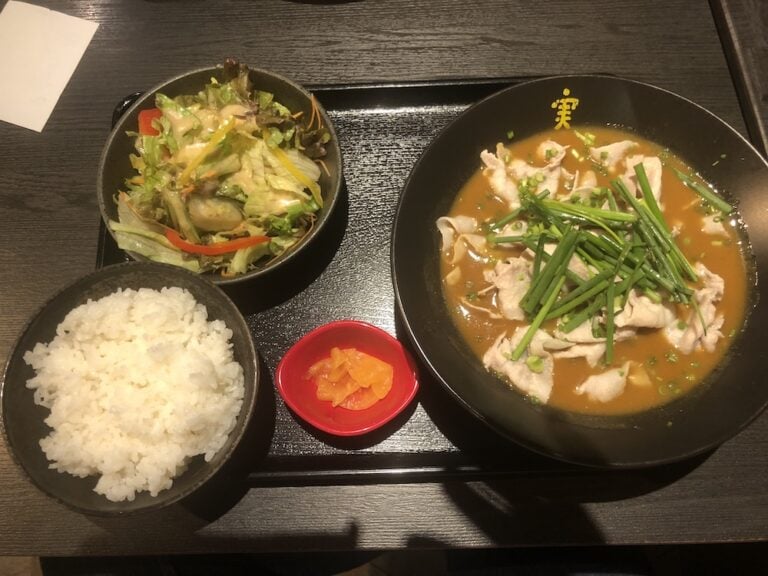
Eating in Japan isn’t just about indulging in amazing food, it’s a whole cultural experience where table manners, respect, and tradition come together. Whether you’re enjoying a casual lunch or being treated to a more formal teishoku (定食) set, getting familiar with Japanese dining etiquette will help you connect with the culture in a meaningful way.
1. The Table Setup: Arranging a Teishoku Meal
When you’re served a traditional teishoku meal, the placement of each dish is no random arrangement. Everything has its place, and here’s the basic layout you’ll find:
- The rice (gohan) is on the lower left, your comforting staple.
- The miso soup (miso shiru) is on the lower right, balancing the meal.
- The main dish, which could be anything from grilled fish to tempura, is positioned at the top center.
- Side dishes like pickled vegetables, tofu, or a simple salad are usually on the upper right.
- Small sauces and condiments sit above or beside the main dish.
The layout is designed to make your meal balanced and harmonious. Japanese dining is all about appreciation, and part of that is finishing what’s on your plate. Leaving food behind, especially rice, can be seen as wasteful and disrespectful. Not sure how much you’ll eat? Start with small portions, and you can always ask for more if you’re still hungry.
2. How to Eat a Teishoku Meal Like a Local
There’s no strict rule about the order in which to eat your meal, but there is a rhythm to it that’s nice to follow. Here’s how to approach it:
- Begin with a sip of miso soup. This helps cleanse your palate and gets your stomach ready for the rest of the meal.
- Take a bite of rice next. Rice is the heart of the meal and is meant to be eaten alongside everything else.
- From there, feel free to alternate between bites of the main dish, more rice, and soup. There’s no need to finish one dish before moving to the next—part of the joy of eating a Japanese meal is experiencing different flavors together.
- Don’t forget to enjoy your side dishes between bites. Pickled vegetables, salads, and tofu are there to add variety to the meal, providing contrast to the main course.
- It’s polite to leave just a little rice and soup to finish at the end. This helps tie the meal together and brings things to a satisfying close.
By alternating between bites of rice, soup, and your main dish, you’re following a natural flow that makes the meal more enjoyable.
3. Chopstick Etiquette: What to Do and What Not to Do
Chopstick manners are important, and getting them right shows respect for both the meal and those around you. Here are a few key points:
- Never stick your chopsticks vertically into your rice. This resembles a funeral ritual, so it’s something to avoid at all costs and is heavily looked down on.
- Don’t pass food from one pair of chopsticks to another. This also mirrors a funeral custom of passing the bones of the departed loved one.
- Avoid pointing at things or gesturing with your chopsticks while you talk. It’s considered to be very rude.
- When taking food from a shared plate, use the back end of your chopsticks. It’s a simple way to be hygienic and respectful in group settings.
4. Where to Sit: The Importance of Seating Arrangements
In Japan, seating arrangements often reflect the status or hierarchy within a group, and knowing where to sit is part of the dining etiquette. Here’s what you need to keep in mind:
- At a traditional low Japanese table (zashiki), guests typically sit on tatami mats. The most honored guest or senior person (or the boss) usually sits furthest from the entrance, as this is considered the safest and most respected spot.
- If you’re visiting someone’s home, it’s polite to wait for your host to seat you rather than picking a spot yourself.
- In a restaurant, if you’re dining with colleagues or superiors, they will be seated in the position of honor (again, furthest from the door), while lower-ranked members will sit closer to the entrance.
- Understanding these small details helps show respect, whether you’re dining with friends, colleagues, or family.
5. Visiting a Japanese Home: Etiquette and Expectations
Being invited to someone’s home in Japan is a special honor, and with it comes a few unwritten rules about how to be a gracious guest.
Bringing a Gift (Omiyage)
It’s customary to bring a small gift when visiting someone’s home. This could be something from your hometown, like sweets or snacks, or something thoughtful that reflects your appreciation. It doesn’t have to be anything fancy but a basket of fruits or a box of sweets are commonly given as omiyage. When offering the gift, present it with both hands, bow slightly and say, “Tsumaranai mono desu ga…” This means, “It’s not much, but please accept this.” It’s a polite and humble way to show your gratitude.
Entering the Home
As soon as you step inside, you’ll need to remove your shoes in the genkan (entryway). Be sure to point your shoes toward the door as you take them off, which helps keep things tidy and clean and easy for you to put on when you are going home. Your host will provide house slippers for you to wear as this is the culture in Japan, so don’t worry about bringing your own.
During the Meal
Once the meal begins, offer to help set the table or ask if there’s anything you can do. Even if your host declines your offer, the gesture will be appreciated. After the meal, it’s polite to offer help with cleaning up or washing dishes, though again, your host will most likely insist that you just relax.
As you dine, always remember to say “Itadakimasu” before starting your meal as it’s considered a simple way to express gratitude for the food. When you finish, be sure to say “Gochisousama deshita,” which means “Thank you for the meal.”
When Leaving
Before leaving, thank your host with a formal phrase like “Osore irimasu” or “O-jama shimashita” (which means “I’m sorry for the intrusion”). It’s a polite way to acknowledge the hospitality they’ve extended to you. It’s customary to do a small bow or if you have a close relationship with the host, even exchange hugs at the end of your visit. Read the room first though, as this is typically not standard for Japanese people.
6. Slurping and Drinking: Is it okay, or not okay?
Believe it or not, slurping is completely acceptable in Japan and is even considered a sign that you’re enjoying your meal. Especially when eating noodles like ramen or soba, slurping enhances the flavor and shows your appreciation.
When it comes to drinking, especially alcohol, never pour your own drink. Instead, pour for others and wait for them to pour for you. And before you take your first sip, be sure to wait for everyone to raise their glasses and say “Kanpai!” which means “Cheers!” Be mindful of these actions especially if it is a company event or drinking party called “Nomikai” in Japanese.
7. Paying the Bill in Restaurants
Japan’s restaurant culture has a few quirks of its own, especially when it comes to paying the bill. Tipping isn’t customary, and it can actually be seen as rude. Instead, just pay the amount shown on the bill. Use the tray provided at the cashier rather than handing the money directly to the server. If you’re dining with others, the bill is often split evenly unless someone offers to treat the group. In most cases, the boss or manager usually foots the bill if it is a company meeting arranged in advance, but be sure to check before running out of the door.
By embracing Japanese dining etiquette—from how you hold your chopsticks to offering your seat to a guest of honor—you show respect for the culture and people around you. It may feel a little overwhelming at first, but following these small customs will make your dining experiences in Japan not just memorable but more meaningful too.















